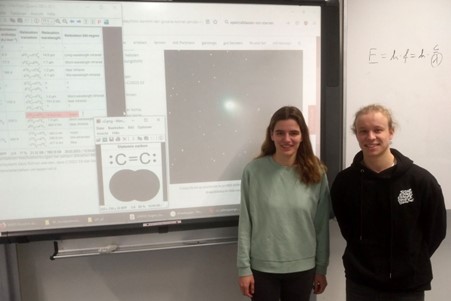-
Faulkes Telescope Project Privacy Policy
Will the Green Comet Ever Return?
Hannah Spieker and Fred Alke, two students in their final year at Gymnasium Nepomucenum in Coesfeld, Germany, conducted some fascinating research about comet C/2022 E3. The comet, which was discovered a year ago, reached its closest point to Earth in its orbit through our solar system in early February 2023. At that time, the local weather did not cooperate for weeks, so they were unable to observe the object with the naked eye, despite their eagerness to do so.

Hannah and Fred using the LCO interface to access the telescopes
However, using the research telescopes of the LCO network, the students were able to catch a glimpse of the comet’s distinct green glow. In order to do so, they took three images with a red, green, and blue filter and put them together in an RGB composite. The result is a beautiful image showcasing the unique green glow of the comet’s coma, formed when volatile components evaporate near the Sun.

The image generated by Hannah and Fred of the Comet C/2022 E3
The green colour of the comet is likely caused by carbon, which is energetically excited by sunlight. The corresponding spectral line of C2 molecules is at 518 nm, an amazing illustration of the principle the students learned in their physics class. According to astronomers, the last time C/2022 E3 may have been close to Earth was about 50,000 years ago, and it is uncertain if it will ever be seen again due to the gravitational interactions during its current visit to the inner solar system.
The discovery by these high school students is a testament to the power of scientific curiosity and the potential of young minds to make meaningful contributions to the world of science. Their discovery of Comet C/2022 E3’s unique green glow has sparked interest among students and teachers alike, and it will undoubtedly inspire others to explore the wonders of our universe.

Hannah and Fred standing by their image and the formula they used to calculate the wavelength of the spectral lines of the C2 molecules
Posted in News
